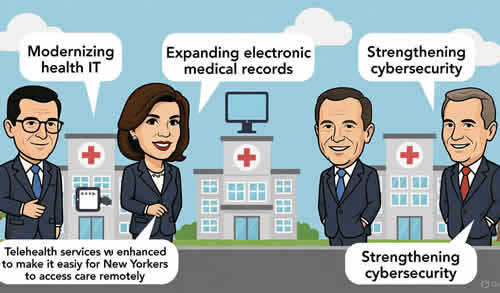September 2024 —The New York State Legislature amended the State Finance Law in 2015 by adding a new Section 8-c. This section established a statewide electronic system aimed at detecting and preventing fraud, waste, and abuse in government spending. It also helps to ensure that public funds are not paid out improperly.
In 2015, the New York State Legislature amended the State Finance Law by adding a new Section 8-c. This section established a statewide electronic system designed to detect and prevent fraud, waste, and abuse in government spending, and to avoid improper payment of public funds. Section 8-c affirms the role of the State Comptroller in protecting public money and mandates cooperation from State agencies and public authorities in this effort.
The Office of the New York State Comptroller (OSC) has made significant progress in using data analytics to enhance its efforts in recognizing and preventing fraud, waste, and abuse. By evaluating and adopting innovative methods and technologies, OSC continuously refines and improves its systems to protect public funds.
Identifying Waste, Fraud, and Abuse
Data analytics is central to OSC’s oversight and internal risk management. These tools and methods are essential for auditing State and local governments and for monitoring and improving State systems related to payroll, procurement, retirement, and other areas. This approach helps increase efficiency and prevent improper payments. Over the past year, OSC has utilized analytical techniques in several notable instances.
Audits Identified Improper Medicaid Payments
Through complex data analytics, OSC identified approximately $2.5 billion in improper Medicaid payments for the year ending May 31, 2024. Examples of these improper payments include:
- Improper coordination of benefits: Medicaid, as the payer of last resort, should only pay after other third-party health insurance, like the Essential Plan, has been exhausted. During authorized overlapping coverage, the Essential Plan should be the primary payer, with Medicaid covering remaining liabilities.
- Hospitals overbilling.
- Payments made to providers not enrolled in Medicaid.
Audits Identified Improper New York State Health Insurance Program Payments
Data analytics were also employed to find improper payments within the New York State Health Insurance Program. This led to cost savings of $32 million by identifying improper drug and dental claims, as well as missed rebates that the State should have collected.
Payment Voucher and Employee Expense Payment Audits
To ensure that State payments are appropriate, accurate, and compliant with laws, regulations, and policies, OSC has developed tools for rapid and systematic analyses of payment vouchers and employee expense payments. These tools use known risk indicators—such as contracts without OSC pre-audit oversight and employees not following the OSC Travel Manual—to provide visualizations that help auditors identify high-risk transactions.
From July 1, 2023, to June 30, 2024, these tools helped auditors prevent the disbursement of inappropriate funds and identify compliance issues totaling over $8.0 million. Findings included vendors not complying with contract terms, incorrect invoice calculations, payments using lapsed funds, and employees exceeding federal meal and lodging per diem rates. Additionally, auditors identified over $2.2 million in confirmed audit findings, including more than $1.5 million in prevented duplicate payments and over $713,000 in payments that did not comply with processing requirements.
Monitoring Transactions to Ensure Legitimacy
To prevent fraud against New York State and Local Retirement System participants,
OSC conducts daily and project-based reviews using data analytics that identify
participants’ transactions deemed to be at high risk for fraud.
A total of 39 fraudulent Retirement Online accounts were identified within a ten-month
period. Once fraudulent online accounts have been confirmed in the daily queries, OSC
takes additional data analytics steps to flag transactions with similar characteristics that
may be potentially fraudulent. Through this process, OSC prevented three fraudulent
loan transactions totaling $85,000 from being paid and monthly retirement benefits
totaling over $22,000 for four members from being diverted. Inappropriate payment
related transactions were avoided for the remaining 32 fraudulent members’ online
accounts.
Further, OSC examiners are prompted to conduct reviews of transactions to check for
fraud when certain conditions are met. If their review reveals a risk of fraud, they flag
the transaction, requiring the member to authenticate it before the payment is
processed. For example, certain changes to NYSLRS account information trigger
notifications to ensure that participants are aware of the changes. Participants can
report that they did not request the change.
Unclaimed Funds Claim Payment Audit Tools
Online unclaimed funds claims comprise 85% of all unclaimed funds claims. The claims
are reviewed within a short window of time to ensure the payment is made to the
entitled owner. OSC increased the use of data analytics and data mining to identify
factors that could make claim payments risky and improve the auditing process. In State
Fiscal Year 2023-24, OUF reviewed 16,205 payments totaling $32.1 million. As a result
4
of the reviews, auditors referred 113 payments totaling $153,071 to OUF claims
processors to stop the payment because the payment did not appear to be made to the
entitled owner. A data visualization identifies risky fraudulent claims prior to completing
the payment process.
Misappropriation of Local Government Funds
OSC uses analytic tools to identify instances where local government officials
misappropriate local government funds. Examples include:
- An audit of the Hannibal Fire Company determined that the former Treasurer
misappropriated over $850,000 of Company funds over a nine-year period. Data
visualizations were prepared to support the auditor’s work and make audit data
meaningful and engaging for both internal and external audiences. This work
supported the findings that the former Treasurer was able to disburse over $451,000
in unauthorized checks to himself from January 2014 through May 2022. Analysis of
credit card transactions for the period April 2016 through May 2022 identified 794
personal cash advances totaling approximately $334,900, as well as over $62,300 in
personal purchases that were not authorized and benefitted the former Treasurer.
(Hannibal Fire Company – Misappropriation of Funds, 2023M-59) - An audit of the Town of Marion found that the former court clerk misappropriated
more than $59,000, or 38 percent of the fines, fees and surcharges collected
between January 1, 2016 through May 31, 2021. Data analytics was used to
examine cases and the associated fines, fees and surcharges, providing the audit
team with targeted data observations for further risk assessment and review. (Town
of Marion – Misappropriation of Justice Court Cash Collections, 2023M-149)
Using Analytics to Improve Program
Effectiveness
OSC audits often identify opportunities to improve data collection and use a broader
range of data sources and analytical approaches to identify ways for agencies to better
manage their programs and operations. Below are some examples from the past year:
Department of Labor (DOL): Services to Workers Under the Worker Adjustment
and Retraining Notification (WARN) Act (2022-S-11)
Under New York State’s Worker Adjustment and Retraining Notification Act (WARN
Act), covered employers are required to give early warning to employees – at least 90
days advance notice (Notice) – of a mass layoff, relocation, or employment loss and to
file a Notice with DOL. Receipt of a Notice triggers staff to offer Rapid Response
services, such as job search and résumé preparation assistance, career counseling,
and occupational skills training, to assist workers in obtaining re-employment as soon
as possible.
The audit analyzed DOL data and uncovered weaknesses in DOL’s oversight that
undermine its success in meeting the needs of dislocated workers, namely: issues with
employer compliance with the Notice requirement; Notices that were not entered into
DOL’s One-Stop Operating System (OSOS), the system used to record related services
to employers and affected employees; and late outreach to employers that submitted
Notices and to affected employees—and in some cases no record of any outreach. The
audit included an interactive map providing information on the industries, geographic
areas, and employees affected.
Interactive dashboard link: https://www.osc.ny.gov/state-agencies/audits/servicesworkers-under-worker-adjustment-and-retraining-notification-act-dashboard
Department of Health (DOH)/Division of Homeland Security and Emergency
Services (DHSES): Oversight of Water Supply Emergency Plans (2021-S-39)
Community water systems that supply drinking water to more than 3,300 people (Water
Systems) are required to prepare and submit a Water Supply Emergency Plan (Plan) to
DOH for review at least once every 5 years.
Plans must include both an Emergency Response Plan (ERP), identifying key contact
information and the location of technical support and replacement equipment for critical
system components; and a Vulnerability Assessment (VA), identifying any vulnerabilities
to non-intentional (e.g., floods, power outages) and intentional (e.g., vandalism,
terrorism) events, along with corrective actions. As of 2018, Water Systems were also
required to include an analysis of vulnerability to terrorist attack, cyberattack, and
natural hazards (Cybersecurity Vulnerability Assessment or CVA) in their VA.
While the audit found that the Plans for most of the Water Systems were current and
available at DOH, it also identified many instances where the ERP or VA had not been
updated in more 10 years since the Water System’s last submission, and some Water
Systems had never submitted a CVA. In addition, DOH did little to follow up when Water
Systems were late in submitting or didn’t submit Plan revisions.
Auditors analyzed data from the Safe Drinking Water Information Systems and DHSES
as part of the audit and also used data visualization software to create a map of the
water suppliers to enhance understanding of the report.
Department of Environmental Conservation (DEC): Monitoring of Air Quality
(Facility Permits and Registrations) (2021-S-41))
OSC audited DEC’s air permitting process and found DEC’s air permitting process is
not adequately allowing residents, particularly low-income and minority communities
(known as environmental justice areas or EJ areas) access to information about the
harmful effects of pollution emitted in their communities as their monitoring of EJ areas
failed to keep pace with the changing demographics over the years.
8
Auditors analyzed DEC data and showed that from 2011 to 2021, many areas of the
State experienced significant shifts in populations and incomes, yet DEC continued to
use its outdated static maps from 2003 despite having updated data in 2011. Of 71
facilities auditors reviewed, 13 are now located in an area that is currently defined as EJ
using the 2021 map criteria but that was not originally defined as such at the time of the
facility’s initial application.
Office of Renewable Energy Siting (ORES): Application Review and Site
Permitting for Major Renewable Energy Projects (2023-S-52)
The Climate Leadership and Community Protection Act (Climate Act), effective January
1, 2020, was designed to put the State on a path to zero emissions in all economic
sectors, enact standards among the most aggressive in the United States, and require
100% carbon-free electricity by 2040, placing New York’s program on par with leading
programs nationally and internationally. Created in 2020, ORES is tasked with reviewing
proposed major renewable energy facilities, and in support of the Climate Act’s
ambitious goals and timeline, its goal was to streamline and expedite the siting process,
9
reducing its time frame for completion from 4–5 years to 1 year, to bring facilities online
faster.
While the audit found that the overall time between application and final siting permit
had improved, the siting permit process is taking significantly longer than projected for a
given project—more than 1 year and in some cases up to 3 years—because certain,
often time-consuming steps are not being accounted for. For the 15 projects that ORES
has reviewed thus far, auditors found that neither the time to issue a notice of
incomplete application and for the applicant to respond nor the time prior to an
application’s transfer to ORES was taken into consideration. For the 14 projects that
received final siting permits, it took an average of 1,094 days (3 years) to deem the
application complete—the longest part of ORES’s process—and, overall, an average of
1,333 days (3.7 years) from the initial application date to the date the final siting permit
was issued. These results were developed by analyzing data from ORES’s Document
and Matter Management System and Open NY. This data was also used to generate a
timeline infographic to foster readers’ understanding.
Metropolitan Transportation Authority (MTA)/New York City Transit (Transit): Risk
Assessment and Implementation of Measures to Address Extreme Weather
Conditions (2021-S-27)
In the decade since Superstorm Sandy, weather predicting models have indicated that,
with rising sea levels, the range and depth of storm surge will increase across New York
City, resulting in more flooding to more property. Coastal flooding caused by storm
surge can cause severe corrosion of Transit’s infrastructure equipment. Protective
measures need to be designed to function while services are still running.
Although Transit has developed winter, hurricane, rain, and extreme heat plans, the
audit found that these plans were inconsistently activated, with no documentation
explaining the rationale for decision making. In the audit’s analysis of data for 18
weather events, it was found that plans had not been activated for six events that
included tropical storms, hurricanes, or coastal flooding. This analysis was based on
weather data obtained from the National Oceanic and Atmospheric Administration.
Promoting Accountability & Efficiency
OSC and other State agencies continue to make extensive data available to the public.
This can help external stakeholders to monitor the use of public money and hold public
officials accountable for carrying out their duties effectively, help identify areas of risk,
and prevent waste, fraud and abuse. However, the data is not always easy to use. To
make public data more user friendly for a broader range of stakeholders, OSC has been
developing interactive web-based tools that allow members of the public to filter and
view data interactively.
Technological advances can also make data analysis easier, faster, and accessible to
more people, as well as promote agency efficiency and effectiveness. Interactive data
visualizations allow State and local officials, managers and other decision-makers to
quickly review data from multiple sources to monitor trends, identify outliers, assess
risks and respond as needed to prevent waste and abuse, identify potential fraud,
improve performance and explain results to residents and stakeholders.
Greater Transparency on State Agency and Public Authority Contracts
In March 2024, OSC launched a new state contracting webpage along with the
Contracts by the Numbers dashboard. The dashboard tool allows users to search and
sort contract data by agency or authority, vendor, and contract type, including contracts
that were not reviewed by OSC.1 OSC maintains financial data and information on over
240,000 state contracts. The Contracts by the Numbers dashboard and web page were
created to provide the public with an easy and user-friendly way to access information
on state contracts.
The webpage also highlights how the Comptroller’s review is an essential and important
deterrent to waste, fraud and abuse and provides statistics and graphs on overall review
timeframes including showing that over 94% of all contracts reviewed by OSC in 2023
were approved or non-approved within 15 days. This is just a fraction of the time for an
overall procurement cycle. Through these contract reviews, OSC can find opportunities
for the agencies and authorities to renegotiate and save costs as well as identify costly
errors.
Identifying Deceased Members
OSC utilizes various tools to identify deceased benefit recipients in order to prevent
New York State and Local Retirement System (NYSLRS) from issuing inappropriate
monthly retirement benefit payments. Continual enhancements and refinements allow
deceased members to be identified timelier and efficiently, promoting program and
operational effectiveness. During the period January 1, 2024, through May 31, 2024,
NYSLRS identified the death of 6,015 monthly retirement benefit recipients and
recovered $1.6 million in overpaid pension benefits. By comparison, $1.5 million was
recovered for the same period in 2023.
Monitoring Emergency Spending
In October 2023, OSC launched a new online tool to monitor emergency spending
related to assistance for asylum seekers by New York State and New York City: the
Asylum Seeker Spending Report. This emergency spending represented a substantial,
non-routine expense for the State and for New York City. By presenting the most
granular spending presentation of State expenses related to this purpose that is publicly
available, the tool enhances transparency and shows why additional funding and
logistical support is needed from the federal government.
The tool presents monthly State spending by activity and agency and annual spending
by New York City by agency. The data are updated monthly and available for download
by users. It also offers links to the Governor’s Executive Orders declaring and extending
the disaster emergency in the State of New York, which also temporarily suspended
competitive procurement requirements and pre-audit review by OSC for contracts and
contract amendments related to the emergency.
Providing Transparency for Adult Cannabis Tax Revenue Payments
OSC is responsible for making adult-use cannabis (AUC) tax revenue payments to
counties and New York City at the direction of the New York State Department of
Taxation and Finance. In late April 2024, OSC released a map displaying the aggregate
AUC revenues collected by retail dispensaries in New York City and all counties in the
rest of the state.
Making MTA Cost Data Meaningful
In October 2023, the Metropolitan Transportation Authority (MTA) released an updated
version of its 20-Year Needs Assessment (TYNA), an assessment of its capital needs
as required by State legislation. Due to the absence of projected costs in the
assessment, OSC applied an inflation factor to the MTA’s 2013 TYNA in its report A
Review of Capital Needs at the Metropolitan Transportation Authority. This adjustment
made it easier to quantify the cost of the 2023 TYNA.
15
With this methodology, OSC estimated that $69 billion was needed over the 10-year
period covering two capital programs from 2015 through 2024, and at least another $43
billion was needed for the next capital program period, from 2025 through 2029.
The 2023 TYNA projected the MTA will have to purchase more than 3,900 subway cars
over the next 20 years to replace existing cars. OSC estimated that the cost of
replacement could approach $15 billion. The estimates added context and transparency
to the MTA’s TYNA and highlighted the urgent need for the MTA to state its priorities
and funding plans as early as possible.
OSC’s implementation of Section 8-c of the State Finance Law has resulted in the
deployment of tools and strategies leading to more effective and efficient systems for
auditing payments, monitoring transactions, allocating resources and sharing valuable
results with appropriate stakeholders. These efforts have in turn spurred the
development of even more robust models and tools. OSC continually evaluates and
refines analytic models to incorporate additional data and apply the best methods to
ensure that models are assessing the areas of most significance and material risk.
OSC will continue to work with State agencies and public authorities to identify business
processes that could be modified to improve the detection of fraud, waste and abuse
and prevent improper payments before they are made. By enhancing the detection of
fraud, waste and abuse, data analytics is reducing the cost of delivering services while
creating a more level playing field for all the entities that do business with New York
State. All New Yorkers stand to benefit from this effort, which safeguards public money
and makes government more transparent, accountable and efficient.
September 1 2024 New York
Office of the New York State Comptroller 110 State Street Albany, New York 12236
ph. (518) 474-4044 www.osc.state.ny.us
Contributors to the Report Division of the Chief Information Office, Bureau of Data Analytics and FirstNY Division of State Government Accountability Division of Local Government and School Accountability Office of Budget and Policy Analysis Office of Operations Office of the State Deputy Comptroller for the City of New York New York State and Local Retirement System
Sources: Office of the New York State Comptroller Thomas P. DiNapoli
https://www.osc.ny.gov/files/reports/pdf/enterprise-fraud-2024.pdf
Big New York news BigNY.com










